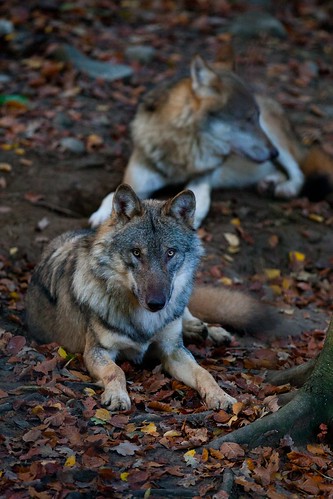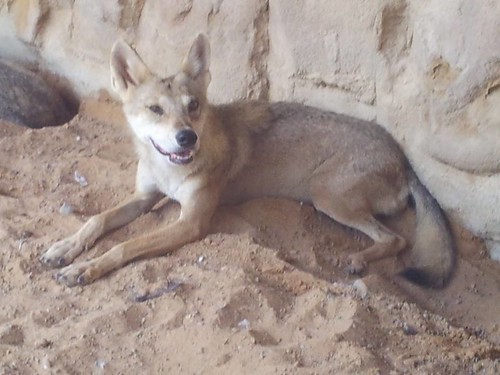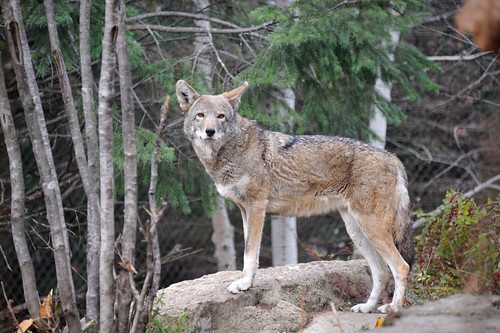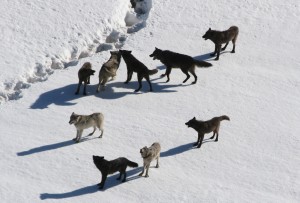The U.S. wants to ban most killing of wild
Mexican wolves in New Mexico and Arizona, and expand the area where the
animals can roam. But many see federal overreach.

The U.S. Fish and Wildlife
Service proposes to extend Endangered Species Act protections for an
estimated 75 Mexican wolves in the wild in New Mexico and Arizona.
(U.S. Fish and Wildlife Service / January 25, 1998)
|
By Julie Cart
October 26, 2013
ALBUQUERQUE — In the small,
rural community of Reserve, children waiting for the school bus gather
inside wooden and mesh cages provided as protection from wolves. Parents
consider the "kid cages" a reasonable precaution.
Defenders of the wolves
note there have been no documented wolf attacks in New Mexico or
Arizona. Fears of wolves attacking humans, they say, are overblown, and
the cages nothing more than a stunt.
In 1995, the reintroduction of Canadian gray wolves into the northern Rockies ignited a furor.
Now that acrimony has
cascaded into the Southwest, where the U.S. Fish and Wildlife Service
proposes to extend Endangered Species Act protections for an estimated
75 Mexican wolves in the wild in New Mexico and Arizona.
Such protections would make it illegal to kill wolves in most
instances. The new federal plan would also significantly expand the area
where the wolves could roam unmolested.
To many conservatives in the West, such protections are examples of
government overreach — idealistic efforts by officials who don't know
what it's like to live with wolves.
"People have to stand up and defend our rights," said Wink Crigler, a
fifth-generation rancher from Arizona who says guests at her tourist
cabins fear they might be attacked by wolves.
Anti-wolf campaigns here — paid for by conservative political
organizations antagonistic toward the federal government — often portray
the animal as a savage devil preying on children.
The antipathy has encouraged scores of illegal killings of Mexican
wolves, whose population dwindled to seven before federal efforts to
reintroduce them began in 1998. A young male wolf was fatally shot with
an arrow a few weeks ago in the same rural Catron County that uses the
kid cages.
Into this atmosphere have come federal officials who by the end of
the year are expected to finalize their plan for managing Mexican
wolves, a smaller and tawnier subspecies of the Canadian grays.
"With the political debate we see raging, we can't just listen to the
loudest voice in the room," said Fish and Wildlife Service Director Dan
Ashe. "There are many loud voices in the room. No animal engenders more
polarizing emotion among Americans than does the wolf."]]
It is a public policy debate driven not just by biology and science, but by emotional appeals and unalloyed partisanship.
When a previously scheduled Oct. 4 public comment hearing about wolf
management was postponed by the government shutdown, advocates came out
anyway, staking out nearby meeting rooms at an Albuquerque hotel.
The Save the Lobo rally, paid for by Defenders of Wildlife, featured a
man in a wolf costume, children scrawling placards with crayons and
people offering videotaped testimony to be forwarded to Washington.
Down the hall, an anti-wolf event was sponsored by
Americans for Prosperity, an organization funded by the conservative Koch brothers. The group offered literature by
Ayn Rand
and screened the documentary "Wolves in Government Clothing," which
equated rampaging wolves with an out-of-control federal government. Said
one Arizona rancher at the event: "Is this politically driven?
Absolutely."
An armed guard patrolled — made necessary, Americans for Prosperity said, by death threats from environmental groups.
The issue of public safety loomed large, with much discussion of the
kid cages, boxy structures that resemble chicken coops. Photos and video
of the cages have been circulated by Americans for Prosperity, although
it was unclear how many exist or who requested or paid for them. Local
media reports suggest at least some of them were built by students in a
high school shop class.
Calls to the superintendent of schools in Reserve were not returned.
To Carolyn Nelson, a teacher in Catron County, the cages don't go far
enough to protect children. She said that seven years ago her son, then
14, was out walking and came across three wolves. Frightened, he backed
against a tree. One wolf stared him down while the other two circled.
Only when the boy cocked the gun he was carrying did the wolves run off.
"I think it was a miracle he wasn't killed," she said.
Crigler, who attended the event, said she understood the fears of the
guests in her tourist cabins. "I can't tell them that they are
perfectly safe. There is some degree of risk," she said. "My concern is
that I see wolves habituated to people. They are meat eaters — savages."
According to wolf researcher Carlos Carroll, who was among the
scientists studying Mexican wolves for the Fish and Wildlife Service,
the probability of wolves targeting humans is low.
"All we can go on is what has happened in the past," said Carroll, a
conservation biologist with the Klamath Center for Conservation Research
in Northern California. "There have been maybe two to three attacks in
the last decade — in Canada and Alaska, where there are thousands of
wolves."
Wolf advocate Michael Robinson with the nonprofit Center for
Biological Diversity said he respected people's fears but added, "The
risk has been greatly exaggerated for cynical reasons."
Likewise, the incidence of wolves killing cattle and sheep is
actually much less common than widely believed. According to the
National Agricultural Statistics Service, about a third of sheep deaths
nationwide are attributable to predators, with wolves accountable for
only 0.4% of those attacks. The data indicate that domestic dogs are
responsible for nearly 20 times more sheep kills than wolves.
Similar numbers hold true for cattle, where wolf kills rank behind
deaths by coyotes, domestic dogs, cougars and vultures, which have
attacked calves.
Ranchers are compensated when they can prove livestock have been
killed by wolves. Crigler lost three calves last year and was reimbursed
by a government program, but she said the payment was below fair market
value.
"It's already hard enough to make a living," she said, adding that a
neighboring cattleman was getting ready to walk away from the business
because of wolves.
It's undeniable that small ranchers and farmers face economic
troubles — and it's common for some people to feel powerless living in
states where the federal government is the landlord of more than half
the landscape.
But some anti-wolf advocates in Albuquerque hold wolves responsible
for such diverging issues as the depopulation of small towns and the
closing of country schools.
"They attach a lot of rancor to wolf recovery that isn't about
wolves," said John Horning, executive director of WildEarth Guardians,
based in Santa Fe, N.M. "It's a symbol. It's about the loss of political
capital, the economic decline of rural life. Wolves are a surrogate for
all the changes that are happening that are very frightening."
David Spady, the California director of Americans for Prosperity and
producer of the anti-wolf documentary, readily agreed that wolves are a
launching pad to air an array of grievances, from taxes to state's
rights.
"The whole debate over the wolf is part of other battles over the
Endangered Species Act and failed government programs," said Spady, who
wore silver wolf-head cuff links.
"The wolf is symbolic of a larger fact: The federal government is
running roughshod over private property rights," he said. "We at the
local level believe that we understand the needs of our place, rather
than somebody in Washington, D.C."
source





















